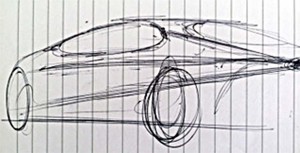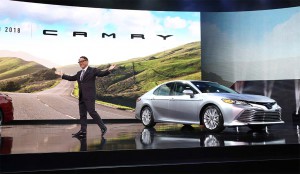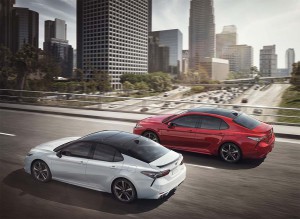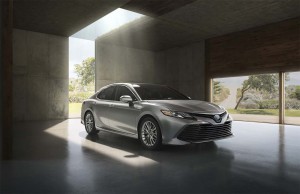Here’s a question for you: how many redesigned sedans have been launched over the last two or three years, and what are they? It’s something Jack Hollis, Toyota Division general manager, asked last week as journalists gathered for the first drive of the completely redesigned Toyota Camry.
“Nothing really stands out,” he said during the event in Oregon. “If you’re a sedan buyer, what are you getting excited about? The new truck, the new crossover the new SUV.”
It’s a concern for Hollis and his employer as Toyota gets ready to launch the fully redesigned midsized sedan later this year. The Camry has been the number one-selling passenger car in the U.S for 19 of the past 20 years, while more than 18 million have been sold worldwide since its launch in 1982. Yet Toyota hasn’t been exempt from the sudden shift in buyer preference, as 63 percent of U.S. car buyers opt for trucks, SUVs, and crossovers rather than passenger cars.
In fact, Hollis and other senior Toyota executives have candidly admitted that there’s a solid chance the Camry could slip to number two in the brand’s U.S. hierarchy this year, behind the RAV4 – the success, or lack of, with the new model the determining factor.
(Toyota leaving nothing to chance with debut of 2018 Camry. Click Here for the story.)
Excluding trucks, Toyota’s car sales fell 9.1 percent in 2016, with Camry declining 9.5 percent. That trend accelerated this year, with Camry seeing demand dip 11.8 percent during the first five months of 2017, outpacing the falloff experienced by the Kia Optima (down 6.6 percent) and the Honda Accord (down 7.3 percent). Still, it’s less than the shortfalls seen by the Nissan Altima (down 16.9 percent), Mazda6 (down 18.6 percent), Ford Fusion (down 26 percent), Hyundai Sonata (down 27.9 percent), and Chevrolet Malibu (down 29.9 percent).
Having long emphasized Camry’s quality, durability, reliability and safety – or QDRS in Toyota speak – has served Toyota well and reliability is still the top purchase consideration among midsize car buyers, according to industry researchers J.D. Power. But in a segment where few vehicles stand out, exterior styling rates third among buyer considerations, just after interior comfort and ahead of other concerns such as fuel economy, quality, performance, and technology.
“We have an opportunity because newness is lacking in sedans,” Hollis said, “and we’re going to get the lead on this.”
Enter the 2018 Toyota Camry, with a distinctive look that’s sure to be polarizing among buyers accustomed to the brand’s traditionally sedate styling. Toyota wanted the redesigned model to be clearly recognizable from 200 feet, the distance from which most buyers see a car when pulling into a dealer parking lot – and they’ve succeeded.
Ian Cartabiano, the car’s designer at Toyota’s Calty Design Research, said inspiration for the new look came from the image of a ballerina on a balance beam. Regardless of what moved his muse, the 2018 Camry’s caffeinated creases endow the sedan with an energetic appearance. While its look is clearly aimed at a younger buyer, who will no doubt appreciate the new Camry’s longer (nearly two inches), lower (one inch), and wider (0.8 inch) stance, the brand’s faithful – if older – clientele may not appreciate a seating height that’s been lowered by an inch in an era where they’re accustomed to sitting higher.
That said, the car’s appearance depends on which model you buy.
The Camry will be available in five grades: a new base-level L trim, followed by LE, XLE, SE and XSE. L, LE, and XLE are mainstream trims with a horizontal front fascia motif. Sportier SE and XSE models are more aggressive, sporting a black-painted roof with matching black-painted rear spoiler and side mirrors, an aggressive black mesh grille and oddly placed non-functional vertical vents below the taillights.

A sketch of the new car by designer Ian Cartabiano, who was inspired by a gymnast on a balance beam.
The polarizing new wardrobe cloaks the automaker’s impressive Toyota New Global Architecture, or TNGA. While some mechanical bits of this all-new platform have been employed on recent Toyota models – notably the fourth-generation Prius hybrid — the 2018 Camry is the first to use the entire package.
Nevertheless, for those familiar with the Camry, the engine lineup will sound familiar. Most buyers will opt for the all-new 2.5-liter four-cylinder engine, although a 3.5-liter V-6 or gas-electric hybrid powertrain are also offered.
Of the three, the vast majority of buyers will opt for the four, although this is an all-new engine, with direct injection and variable valve timing. It produces 206 horsepower at 6,600 rpm, and 186 foot-pounds of torque at 5,000 rpm. The same engine in the Hybrid generates 176 horsepower at 5,700 rpm and 163 foot-pounds of torque at 3,600-5,200 rpm with net horsepower rated at 208.
Toyota’s decision to keep a V-6 in the Camry line-up came as something of a surprise, as most mainstream competitors have been switching to all-four line-ups. That includes Honda which will unveil its next-generation Accord models in just a few weeks. The Camry V-6, chosen by just six percent of Camry buyers, is mostly carryover although it produces 301 horsepower at 6,600 rpm and 267 foot-pounds of torque at 4,700 rpm.
(What’s in store for the 2018 Honda Accord? Click Here to find out.)
The EPA estimates the four-cylinder’s fuel economy at 34 mpg combined, a 26 percent improvement from 2017’s four-cylinder. The Hybrid’s numbers are better, with Hybrid LE rated at 52 mpg combined, although SE and XLE Hybrids are rated lower, at 46 mpg combined. (The difference may be due to the batteries used for the different models. The LE Hybrid uses a more advanced lithium-ion battery, while the other Hybrid models use time-tested Nickel-Metal Hydride technology.) By comparison, the V-6 is rated at 26 mpg.
Both the four- and six-cylinder engines mate to an eight-speed automatic transmission, while the Hybrid pairs to a continuously variable automatic transmission. All Camrys are front-wheel drive; all-wheel drive is not offered. In an effort to endow the car with better handling, the Camry uses MacPherson struts up front and a new double wishbone suspension in the rear.
Surprisingly the V-6 doesn’t feel as powerful as its figures suggest, although it still seems sufficiently peppy. But the V-6 seems at the limits of power delivery as torque steer and squealing tires reveal the limits of this front-wheel-drive platform. Otherwise, it’s admirably poised, remaining flat while carving corners. And when it comes time to dealing with the nation’s crumbling infrastructure, you’ll find body motions are minimal, and bump absorption is impressive.

Higher trim packages like this Camry XSE come with a range of features - but no steering wheel heater.
By comparison, the four is significantly less nose heavy, and the car has a lighter, more tossable feel. There’s less power, requiring drivers to keep their foot buried in the throttle to extract any muscle, especially given the thrifty shifts of the transmission, which hesitates to downshift for better fuel economy, even in manual mode. But burying the throttle also makes the car significantly noisier, especially given the difference in tires among the various models. Enthusiasts won’t mind, but your average Camry buyer might.
The Hybrid performs similarly to any Toyota hybrid model, with strong off-the-line performance. It’s a must-drive against the traditional four-cylinder variant. In fact, be sure to drive the traditional LE/XLE against the SE/XSE; you’ll find the latter to be the better choice.
(Even in era of cheap gas, fuel economy still drives consumer choice. Click Here for the story.)
Toyota’s Safety Sense suite is standard, and includes 10 airbags, stability control, traction control, electronic brake-force distribution, brake assist, anti-lock braking system, backup camera, pre-collision system with pedestrian detection, radar cruise control, lane departure alert with steering assist, and automatic high beams. Higher-end models also have a blind spot monitor and rear cross traffic alert.
Regardless of which model you choose, you’ll find the beautifully designed cabin to be exceptional for a car of this class. An artistically shaped infotainment panel anchors a sculpted dashboard that imparts an eloquent, flowing motion.
And look closely; the door panels have a brushed metal detail strip that flows impeccably into the door handle. Then there are the seat heater buttons and indicators that resemble lights from a drag strip. And let’s not forget the stitching on the IP – the latest trend in car interiors – that adds an upscale allure.
The cabin is spacious, with more than enough legroom for Chipotle-fed Americans, The seats felt firm with little give, yet proved comfortable and supportive. Surprisingly, there’s a lack of convenience features on fully loaded models. So don’t expect seat memory, heated steering wheel, rear seat heaters or seat ventilation, although a head-up display is offered.
Entune 3.0, the latest version of Toyota’s infotainment system, boasts a vastly improved user interface. But don’t expect Apple Car Play or Android Auto, and don’t expect an embedded navigation system either unless you get a top-of-the-line model. Instead, buyers get to tether the Scout app through Bluetooth from their mobile phone.
There’s little doubt that the 2018 Toyota Camry is significantly better than the model it replaces. But in its effort to make the car more relevant to Millennials, the question remains whether Toyota has gone a step too far with its polarizing look.
Has it become the aging uncle who’s trying to act like his young niece or nephew?





